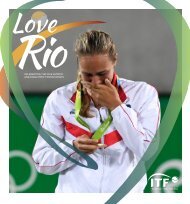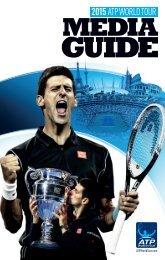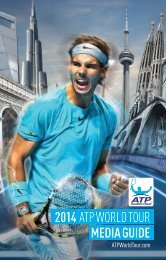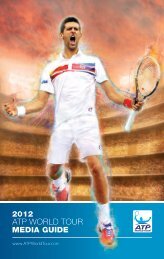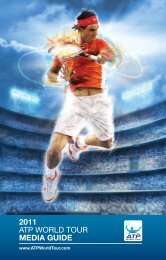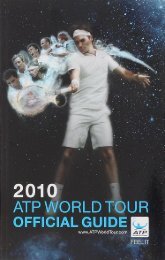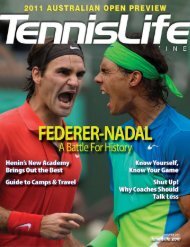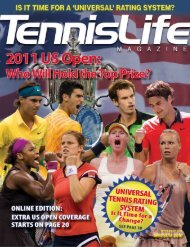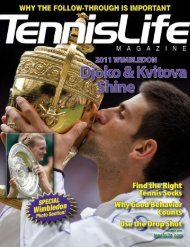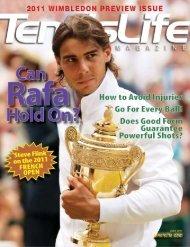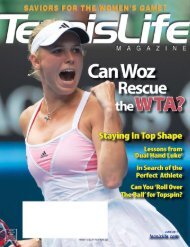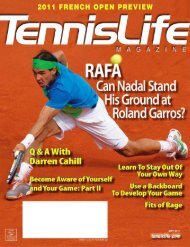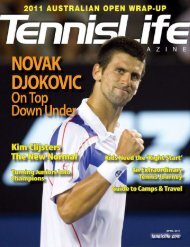A Champion's Mind - Pete Sampras
www.tennismoscow.me Insta:TENNISMOSCOW
www.tennismoscow.me Insta:TENNISMOSCOW
You also want an ePaper? Increase the reach of your titles
YUMPU automatically turns print PDFs into web optimized ePapers that Google loves.
the forehand down the T in the ad court. That left me looking at more second serves, which were then<br />
easier to take with the forehand. The strategy also worked against Michael Chang big time, because<br />
Michael’s serve was relatively weak and easy to attack with a big forehand return.<br />
At the start of our relationship, Tim thought I was getting a little “handsy”—inclined to use my hands<br />
loosely to compensate for a lack of technical discipline. In other words, I was a little lazy. Hands and<br />
wrists play a role in almost all of your shots, but they shouldn’t be doing work intended for your arms,<br />
feet, and torso when it comes to hitting a firm, penetrating shot. It’s especially tempting for players with<br />
good touch to get handsy, and they always pay a price in the way of less weight and penetration on their<br />
shots.<br />
Tim firmed up my backhand volley and slice, or underspin, shot. He had me shorten up my backhand<br />
slice motion to get a little more weight behind the shot even if it meant less spin—à la Ken Rosewall,<br />
whose famous slice was surprisingly firm and heavy. Soon my backhand produced fewer “floaters.” It<br />
penetrated better and went through the court more quickly. That made it harder to attack.<br />
On the backhand volley, we focused on getting my entire body down lower to meet the ball. Dropping<br />
the racket head always robs a shot of pace; it’s one of those things handsy people do. But the firmest<br />
volleys are hit more decisively, with more weight behind the racket. That calls for a little positioning,<br />
which is a little more work, but it paid off. These tunings all helped, and shortening up my backswings on<br />
all my returns was of critical importance in my transformation into a good grass-court player.<br />
But the biggest area of concern for Tim was my attitude on court. I tended to slump and slouch,<br />
especially when things weren’t going my way. Anyone can play great tennis when he’s firing on all<br />
cylinders. The challenge is to play well enough to win when you’re not at your best. There’s a sneering<br />
inner judge in all of us, and a big part of being successful is tuning him out. And sometimes you have to<br />
fight through the indifference and fatigue you sometimes feel, even at big events. Instead of listening to that<br />
judge when he says you’re lousy, or should pack it in because you’re tired and there’s always next week<br />
—that’s when you need to suck it up and act like a man—hang on, fight on, show the pride of a champion.<br />
Tim understood that I wasn’t fully evolved as a competitor. I was a little soft. He kept telling me never<br />
to worry about what happened on the last point, or the one before. He wanted me to intimidate opponents<br />
with my bearing as well as my game, and it drove him nuts when I slouched. But I’m a lanky guy, with<br />
pretty wide shoulders, so the slouch was deceptive. People described my “hangdog” look a million times<br />
in print, but there was a big difference between “young hangdog” and “old hangdog.” Early in my career, I<br />
slouched and wore a grim expression that advertised my discouragement. Later, the grim look denoted<br />
absolute focus, and the slouch hinted of a gathering storm. Some people even suggested that I was a<br />
sandbagger—looking one way but playing another.<br />
As a blue-collar-type guy, Tim was all about the work, all about wringing every bit of potential out of<br />
my game. That’s what he and his twin brother, Tom, had done to make it on the pro tour. Tim tried to turn<br />
me into a rough-and-tumble, confident, take-it-as-it-comes guy. It was a tough task, and the results were<br />
definitely mixed, because in the end I was built differently from Tim, and a leopard doesn’t change its<br />
spots.<br />
The Davis Cup debacle was still fresh in my mind in early 1992, and as an old-school, Davis Cup–loving<br />
kind of guy, Tim put priority on helping wipe the bitter taste of that Lyon final out of my mouth. As it<br />
turned out, the opportunity came up the following January, shortly after the Australian Open. (After an<br />
exhausting 1991, I chose to work with Tim instead of making the trip to Melbourne.) In the first round of<br />
the ’92 competition, the United States had been drawn to play Argentina, and we were the hosts. The<br />
USTA decided to play in Hawaii on hard courts, knowing that the location would appeal to our top<br />
players, who were likely to be traveling homeward after going deep in the draw in Australia.



